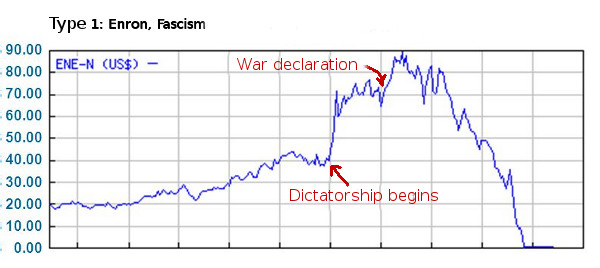
Revolutions share a common origin. Right wing social movements have their root in socialism. Every reactionary attempt at ‘restoring order’ is mortally poisoned by the ease with which leftist Utopian ideas spread and gain acceptance even with their enemies.
Plus some obligatory ramblings about Islam.
A comment posted under my article discussing the fickle behavior of voters inspired me to further elaborate on the nature of the political crisis ahead of us (Europeans, at least).
The idea being: we’re facing a phase of instability, characterized by erratic election results but no significant choices being made, other than letting the current course continue unabated (top-down economic policies, EU mega-state “integration”; restrictions on freedom of speech, especially for non-Muslim religious groups; moral decay, gradual abolition of the family, culture of death; ethnic substitution through immigration).
I compared the current situation, with many changes of direction but no real movement, to the sideways, narrow-band fluctuations in the graph of some publicly traded security: traders study those market patterns to discover early signs of a sudden breakout move, with the price of a stock violently raising or falling.
I was asked: “Ok, what do you think is going to happen, then? In which direction is the graph going to suddenly turn?”
That made me think.
How do I translate a left/right political divide using just a graph?
A simple diagram cannot possibly visualize the complexity of all the concomitant political choices: it is uni-dimensional after all, limited to describing the evolution of a single variable over time.
I’m focusing then on what I deem to be the single most significant variable in the present geopolitical scenario: let’s call it Patriotism.
Under normal circumstances it’s the economy that wins you an election. But we’re living under exceptional circumstances; on top of that, outlining a significant partisan (left-right?) divide based solely on economics is now harder than ever.
Furthermore, voters often disagree on various policy choices or on ethical values, but that’s not the kind of things that fills the average guy with enough passion to support a revolution.
What really makes people click, instead, is the idea that they may be facing a major transformation of the world around them; that anything is possible now. But they may lose everything they care for.
A well known trope is that stock markets are dominated by two emotions, greed and fear.
But that’s true for revolutions too.
Humans desire and act (sometimes, if lured/pushed the right way), fear and react.
The need for security (the urge to protect your family, your possessions and your way of life) is pitted against the desire to take revenge on the rich/some scapegoat group/society.
Either you love your country as it is or think that the entire system is corrupt and decrepit, in need of being torn down.
A Reaction, eventually. Or maybe not.
The focal point of today’s politics is globalists attacking the essence of the Western Civilization, pretending that borders should and could be abolished, versus a (increasingly less) silent majority that may eventually mount a reaction in the name of common sense.
Scenario 1. Sadly, such backlash, being long overdue and triggered by violent leftist extremism, insane legal bullying and self-destructive policy choices, and emotionally charged confrontations, will diverge from that wisdom that ideally was meant to inspire it. Despite their best efforts, nobody will restore sanity. They’ll express instead an opposite form of insanity.
The key factor for people to turn violent and unreasonable will be a very present and tangible threat of becoming strangers in their own country, bullied into submission by external forces enabled by the leftists. Enter Islam…
After years and decades of leftists crying wolf and passive-aggressively crybullying normal people into submission, a majority will have enough and will finally deliver all that xenophobic, homophobic and Islamophobic hatred that was so vehemently denounced in absentia.
Street violence in fact will stop (again) from being an almost exclusive domain of the Left and its allies, and the resulting oppression will be described by future leftists as typical of “the Right”.
Scenario 2. But there’s another scenario, of course, where the forces of reaction will never be able to coalesce into a movement, reaching critical mass. In those tragic cases, the empty shell of a once prosperous European country will become a vulture’s meal.
The nihilistic, self-defeating nature of today’s pop culture will further erode our ethos, culture, self-image and resolve. We (Europeans) are on the road to self-annihilation, excusing ourselves out of history.
Since nature abhors a void, someone will take the lead. Islam is the ideal candidate for the role.
In both scenarios in fact Islamists will be the essential catalyst.
Those who won’t outlaw Islam (and this will sadly involve unjust and cruel decisions) will probably end up as dhimmis, i.e. in a state of total submission to the new Islamic élite of the country.
Sharia, by its very nature, can only be either forbidden or obligatory. That’s probably the subtle psychological reason for leftists to sympathize with Muslim supremacists. A penchant for granting unfettered power to a state entity that embodies one’s ideology. Birds of a feather etcetera.
Visualizing it all
In our graph the x axis represents time; the y axis indicates the perceived value of a nation, which is of course different from its actual value, even if it could be quantified somehow.
Figure 1 represents a possible evolution of the political scene: the one I had in mind when I made my original remark.
The graph itself depicts the evolution of Enron stock price: the infamous energy company that went from rising star/financial behemoth to bankrupt in no time, thanks to a major creative accounting scandal.

Now let’s interpret it as illustrating a Type 1 political crisis: think of a fascist regime.
A patriotic sentiment grows; after a period of instability, fighting against opposite forces, a coup takes place; the majority then either feels relieved that their political enemies seem defeated, or just enjoys going with the flow: this is the age of thundering applause and huge crowds in Piazza Venezia hailing Mussolini as a great leader.
A significant boost in enthusiasm and self-identification is observed.
The graph may rise again in response to other major events (typically, a war) but the increase is short-lived: reality eventually reasserts itself.
A bold, aggressive strategy inflates the market value of the nation way beyond what was achievable given the underlying fundamentals. The price tumbles down.
Despair kicks in; people seem to wake up from a weird dream.
Notice that the graph goes to zero, but that doesn’t mean that the country just vanishes. The same goes for a bankrupt company: despite the fact that a lot of value has been lost forever (think about human and capital losses in a war), there are still significant assets to put to good use. It’s just that someone else acquires those assets at fire sale prices, and a new state entity begins.
Figure 2 represents the opposite scenario, originally depicting the slow death of Kodak, a company that was made irrelevant by a technological tidal shift.

Here you can see that the eventual demise wouldn’t become easily apparent to the casual onlooker focusing on short term swings, because, as always, all sorts of external events / minor positive news may determine a brief rise, deceptively hinting at a comeback. Ultimately, though, all the ups and downs represent just noise. The overarching trend is that of crashing into the ground.
Applying the Progressive Mantra: if at first you don’t succeed, keep going and redouble your efforts. (Subtext: Never question the soundness of your vision.)
In this scenario the entire strategy, one that is usually applied with wicked determination to the bitter end, is that of proactively encouraging the decadence of a once strong and productive country/civilization, through morally lax standards, misallocation of resources, strangling bureaucracy, poisoning culture and education, destroying values and questioning all that was held holy before; siding with deviants, criminals and rabble-rousers; ultimately through population substitution.
This is how it could end for some European countries.
Seeing a dismal future unravel in front of your very eyes.
It’s a perfect storm: tearing down the West while others, from all over the developing world, come to Europe to take our place. Many different cultures, but only Islam gives people enough credible promises to cast itself as a worthwhile -indeed, strong and quite bold- substitute.
We’re getting used to hearing of jihadists attacking non-Muslims on European soil from time to time; and that’s just because the evening news bulletin doesn’t dwell too much on the numerous murders by Islamists committed on other continents. But of course a mentally unstable guy, running over Muslims in a London street (in the name of some twisted idea of revenge) becomes a juicy opportunity for the media circus.
An occasion to endlessly drone on about Islamophobia and the need to… well, deny reality.
Pretending that criticizing the aggressive nature of Islam, or trying to reassert our traditional values, would cause horrible anti-Muslim crimes. The whole point being, to them our only hope is a delusional fantasy of multiculturalism; therefore let’s insist indoctrinating the masses: to every action the only possible reaction is a lack of reaction. Or, to put it another way, self-restraint, self-criticism and further concessions to the least multicultural group ever.
People get exasperated. You can’t play dumb forever.
There’s a long overdue correction in the graph. Wait for it.
A faint hope
Here’s one brilliant way of dealing with the problem, by the Christian apologist David Wood, in a Youtube video well worth your time.
David here cites John F. Kennedy:
“Those who make peaceful revolution impossible will make violent revolution inevitable.”
against the idea that there’s no peaceful way of dealing with Islam other than pretending religion is a neutral factor in a society, like folk music or ethnic cuisine.
If you consider peace only achievable through desensitization and relativism, avoiding any strong feelings about right or wrong, pretending naked prostitutes could share a sidewalk with burqa-clad Muslim women indefinitely, then you’re delusional and facing extinction.
The future will be of those who care; deeply. And are willing to fight.
People like David Wood are constantly harassed and threatened because they dare dedicate their life to a thoroughly documented critique of Islam, highlighting how terrorists are indeed good Muslims in the footsteps of Muhammad (despite protestations of the contrary) and inviting people to leave such a violent and incoherent system of belief.
This is a peaceful way of facing the next crisis. Trying to give people a choice, for a better world, through preaching and dialogue.
Otherwise, see scenarios 1&2.
What is your alternative?
You may object that the crisis of the West is wholly independent of Islam and recent immigration. True.
But events are converging to a single point of failure.
Interesting times.
Western culture is facing a fatal opportunity through an external challenge, spurring our nations to find their raison d’être in the profound wisdom of the Christian faith. A faith that built cathedral, hospitals, human rights and political institutions.
Roots.
A necessary move: finding our way, again.
There’s always a choice. If you want to avert the establishment of Sharia; if you also want to avoid a Fascist regime; a third way could only be found in Christianity.










































